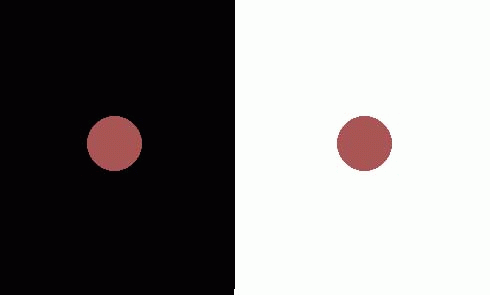Not convinced they are identical? Prove it by completely covering the black and white backgrounds with a piece of paper, and cut two small holes in the positions of the dots to let you see only the dots.


Discussion of light beams
How bright is a light?
We have to be careful in using our eyes as a judge of brightness of light. Eyes are able to adjust over a wide range -- this is necessary for life, since we need to be able to see both in sunlight and in moonlight (and sunlight delivers about 200,000 times more energy in a second to a given area than the full moon does!). This is why cameras are so complicated: they need all these adjustments that our eyes can do for us.
An example of this kind of adjustment came up when we were looking at brightly lit objects with our spectroscope. Any single object seems to reflect all colors of the spectrum. If you position the spectroscope so that the top half of the slit is looking at something that is orange and the bottom half is looking at something green, now you can see that their spectra are different. But the brain doesn't seem to notice the difference in brightness of different parts of the spectrum very well. It knows how to compare but not how to measure. You can see the differences in the spectra of light reflected by green and orange objects, but you have to really concentrate on what you are seeing through the spectroscope.
In the same way, when we look through a stack of colored filters, our eye detects a little light and we start discussing what color it is, when the real point is that there is hardly any light coming through at all.
There is a good reason why the brain tends to ignore the relative proportion of different colors. White light indoors is rather different from the white light of sunlight, which is in turn different from the white light of skylight, the lighting under a tree, or the lighting at sunset. But we need to recognize things (for example, tigers) no matter how they are illuminated! And so the brain makes adjustments to what has been detected. This means that the perceived color of an object depends a bit on its context or environment.
As an example, the disks in the picture below are exactly the same color
(in the sense that they are emitting the same amount of light of the same
mixture of wavelengths), but they don't look the same.
Not convinced they are identical? Prove it by completely covering
the black and white backgrounds with a piece of paper, and cut two small
holes in the positions of the dots to let you see only the dots.


Discussion of light beams